Benefits of Cross-Cultural Communication in an Organization
VerifiedAdded on 2022/08/28
|10
|2456
|31
AI Summary
Contribute Materials
Your contribution can guide someone’s learning journey. Share your
documents today.
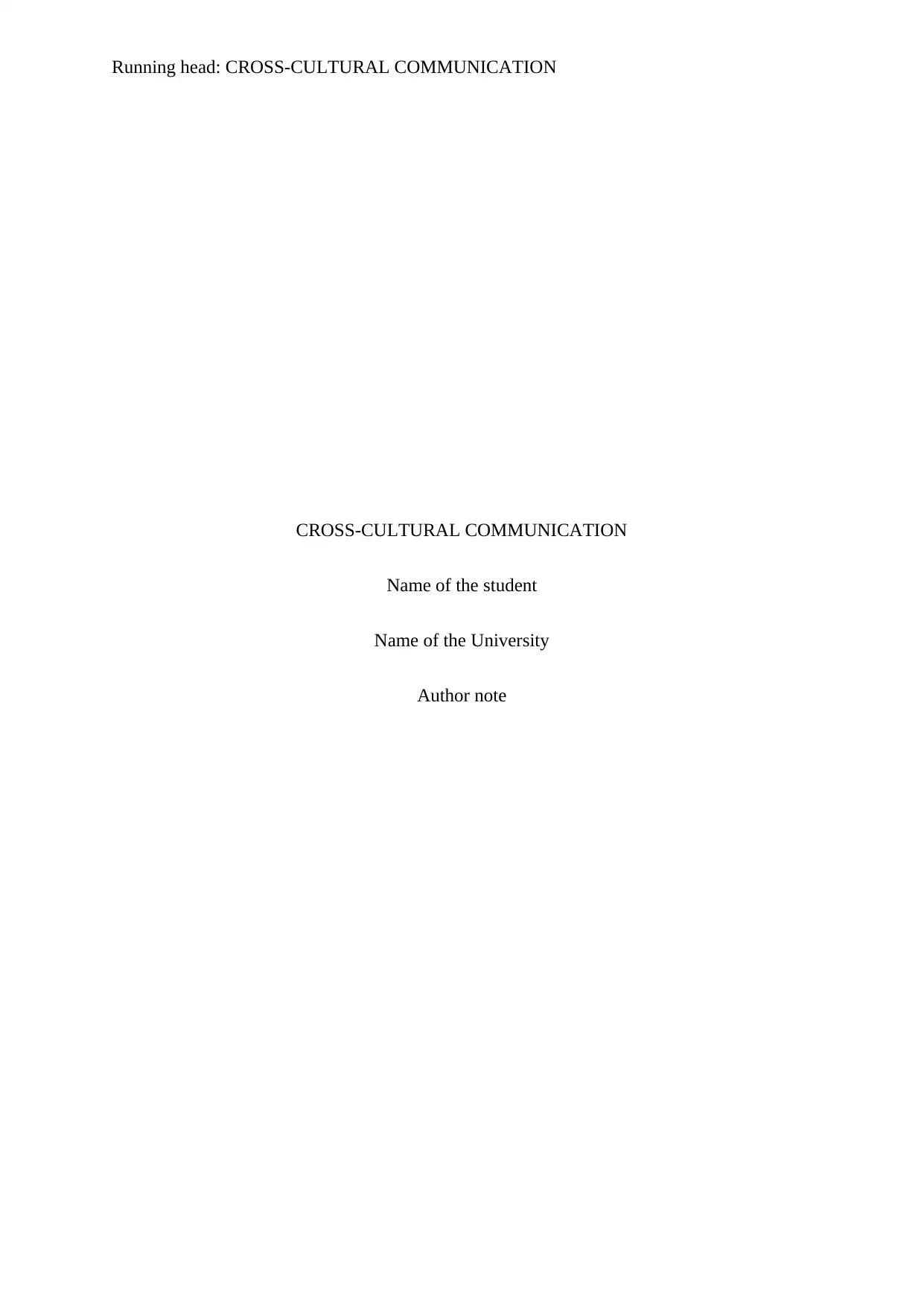
Running head: CROSS-CULTURAL COMMUNICATION
CROSS-CULTURAL COMMUNICATION
Name of the student
Name of the University
Author note
CROSS-CULTURAL COMMUNICATION
Name of the student
Name of the University
Author note
Secure Best Marks with AI Grader
Need help grading? Try our AI Grader for instant feedback on your assignments.
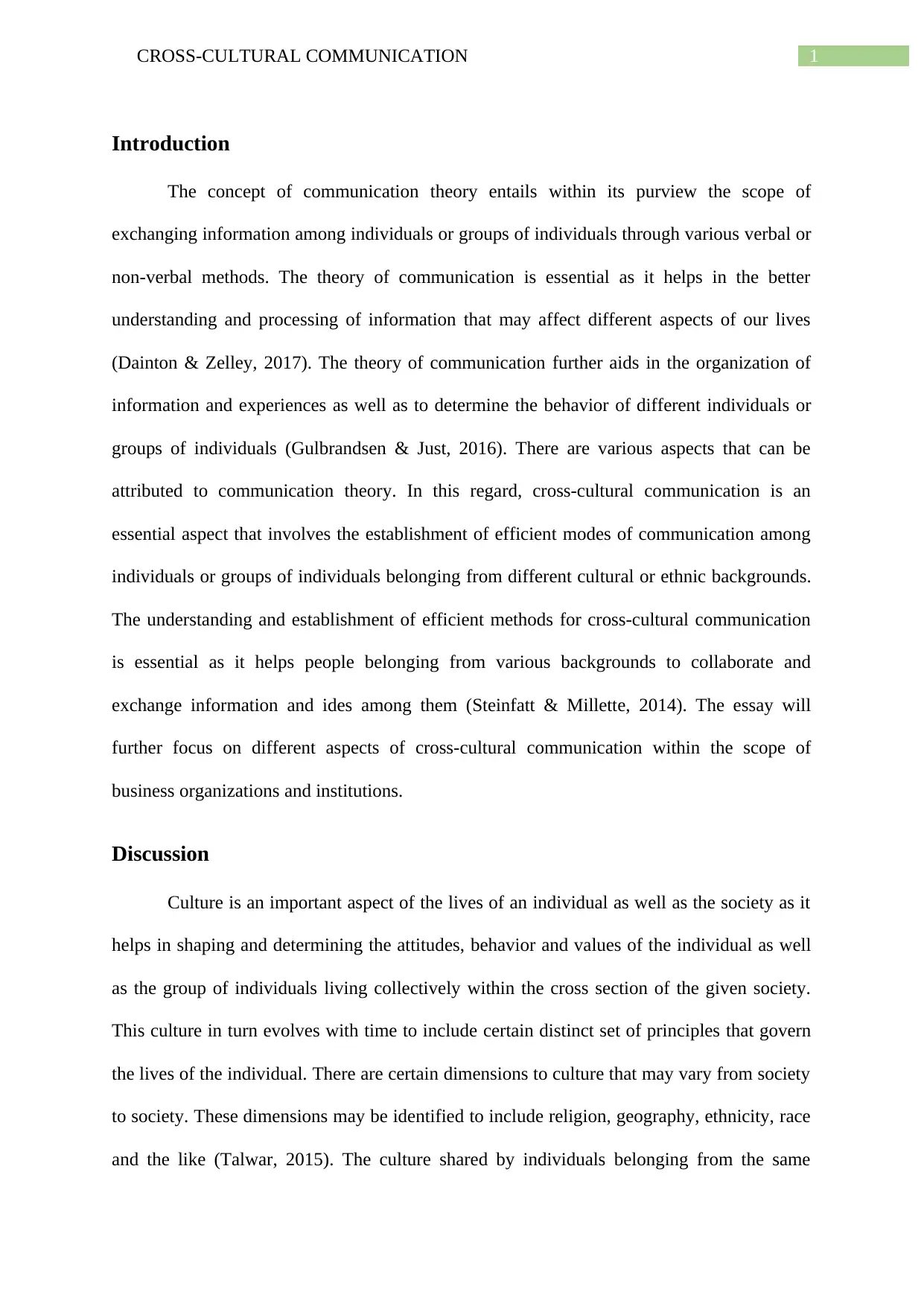
1CROSS-CULTURAL COMMUNICATION
Introduction
The concept of communication theory entails within its purview the scope of
exchanging information among individuals or groups of individuals through various verbal or
non-verbal methods. The theory of communication is essential as it helps in the better
understanding and processing of information that may affect different aspects of our lives
(Dainton & Zelley, 2017). The theory of communication further aids in the organization of
information and experiences as well as to determine the behavior of different individuals or
groups of individuals (Gulbrandsen & Just, 2016). There are various aspects that can be
attributed to communication theory. In this regard, cross-cultural communication is an
essential aspect that involves the establishment of efficient modes of communication among
individuals or groups of individuals belonging from different cultural or ethnic backgrounds.
The understanding and establishment of efficient methods for cross-cultural communication
is essential as it helps people belonging from various backgrounds to collaborate and
exchange information and ides among them (Steinfatt & Millette, 2014). The essay will
further focus on different aspects of cross-cultural communication within the scope of
business organizations and institutions.
Discussion
Culture is an important aspect of the lives of an individual as well as the society as it
helps in shaping and determining the attitudes, behavior and values of the individual as well
as the group of individuals living collectively within the cross section of the given society.
This culture in turn evolves with time to include certain distinct set of principles that govern
the lives of the individual. There are certain dimensions to culture that may vary from society
to society. These dimensions may be identified to include religion, geography, ethnicity, race
and the like (Talwar, 2015). The culture shared by individuals belonging from the same
Introduction
The concept of communication theory entails within its purview the scope of
exchanging information among individuals or groups of individuals through various verbal or
non-verbal methods. The theory of communication is essential as it helps in the better
understanding and processing of information that may affect different aspects of our lives
(Dainton & Zelley, 2017). The theory of communication further aids in the organization of
information and experiences as well as to determine the behavior of different individuals or
groups of individuals (Gulbrandsen & Just, 2016). There are various aspects that can be
attributed to communication theory. In this regard, cross-cultural communication is an
essential aspect that involves the establishment of efficient modes of communication among
individuals or groups of individuals belonging from different cultural or ethnic backgrounds.
The understanding and establishment of efficient methods for cross-cultural communication
is essential as it helps people belonging from various backgrounds to collaborate and
exchange information and ides among them (Steinfatt & Millette, 2014). The essay will
further focus on different aspects of cross-cultural communication within the scope of
business organizations and institutions.
Discussion
Culture is an important aspect of the lives of an individual as well as the society as it
helps in shaping and determining the attitudes, behavior and values of the individual as well
as the group of individuals living collectively within the cross section of the given society.
This culture in turn evolves with time to include certain distinct set of principles that govern
the lives of the individual. There are certain dimensions to culture that may vary from society
to society. These dimensions may be identified to include religion, geography, ethnicity, race
and the like (Talwar, 2015). The culture shared by individuals belonging from the same
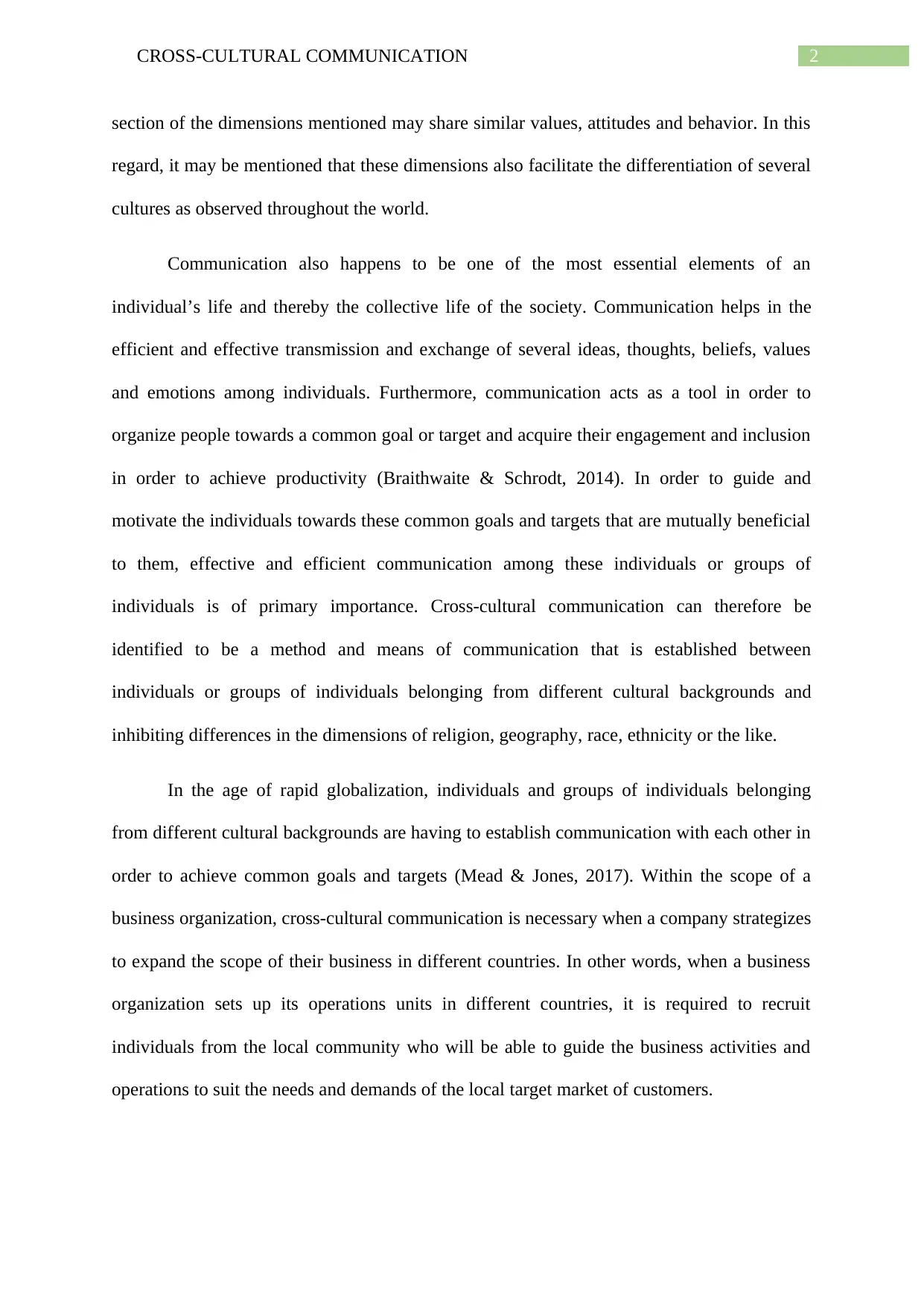
2CROSS-CULTURAL COMMUNICATION
section of the dimensions mentioned may share similar values, attitudes and behavior. In this
regard, it may be mentioned that these dimensions also facilitate the differentiation of several
cultures as observed throughout the world.
Communication also happens to be one of the most essential elements of an
individual’s life and thereby the collective life of the society. Communication helps in the
efficient and effective transmission and exchange of several ideas, thoughts, beliefs, values
and emotions among individuals. Furthermore, communication acts as a tool in order to
organize people towards a common goal or target and acquire their engagement and inclusion
in order to achieve productivity (Braithwaite & Schrodt, 2014). In order to guide and
motivate the individuals towards these common goals and targets that are mutually beneficial
to them, effective and efficient communication among these individuals or groups of
individuals is of primary importance. Cross-cultural communication can therefore be
identified to be a method and means of communication that is established between
individuals or groups of individuals belonging from different cultural backgrounds and
inhibiting differences in the dimensions of religion, geography, race, ethnicity or the like.
In the age of rapid globalization, individuals and groups of individuals belonging
from different cultural backgrounds are having to establish communication with each other in
order to achieve common goals and targets (Mead & Jones, 2017). Within the scope of a
business organization, cross-cultural communication is necessary when a company strategizes
to expand the scope of their business in different countries. In other words, when a business
organization sets up its operations units in different countries, it is required to recruit
individuals from the local community who will be able to guide the business activities and
operations to suit the needs and demands of the local target market of customers.
section of the dimensions mentioned may share similar values, attitudes and behavior. In this
regard, it may be mentioned that these dimensions also facilitate the differentiation of several
cultures as observed throughout the world.
Communication also happens to be one of the most essential elements of an
individual’s life and thereby the collective life of the society. Communication helps in the
efficient and effective transmission and exchange of several ideas, thoughts, beliefs, values
and emotions among individuals. Furthermore, communication acts as a tool in order to
organize people towards a common goal or target and acquire their engagement and inclusion
in order to achieve productivity (Braithwaite & Schrodt, 2014). In order to guide and
motivate the individuals towards these common goals and targets that are mutually beneficial
to them, effective and efficient communication among these individuals or groups of
individuals is of primary importance. Cross-cultural communication can therefore be
identified to be a method and means of communication that is established between
individuals or groups of individuals belonging from different cultural backgrounds and
inhibiting differences in the dimensions of religion, geography, race, ethnicity or the like.
In the age of rapid globalization, individuals and groups of individuals belonging
from different cultural backgrounds are having to establish communication with each other in
order to achieve common goals and targets (Mead & Jones, 2017). Within the scope of a
business organization, cross-cultural communication is necessary when a company strategizes
to expand the scope of their business in different countries. In other words, when a business
organization sets up its operations units in different countries, it is required to recruit
individuals from the local community who will be able to guide the business activities and
operations to suit the needs and demands of the local target market of customers.
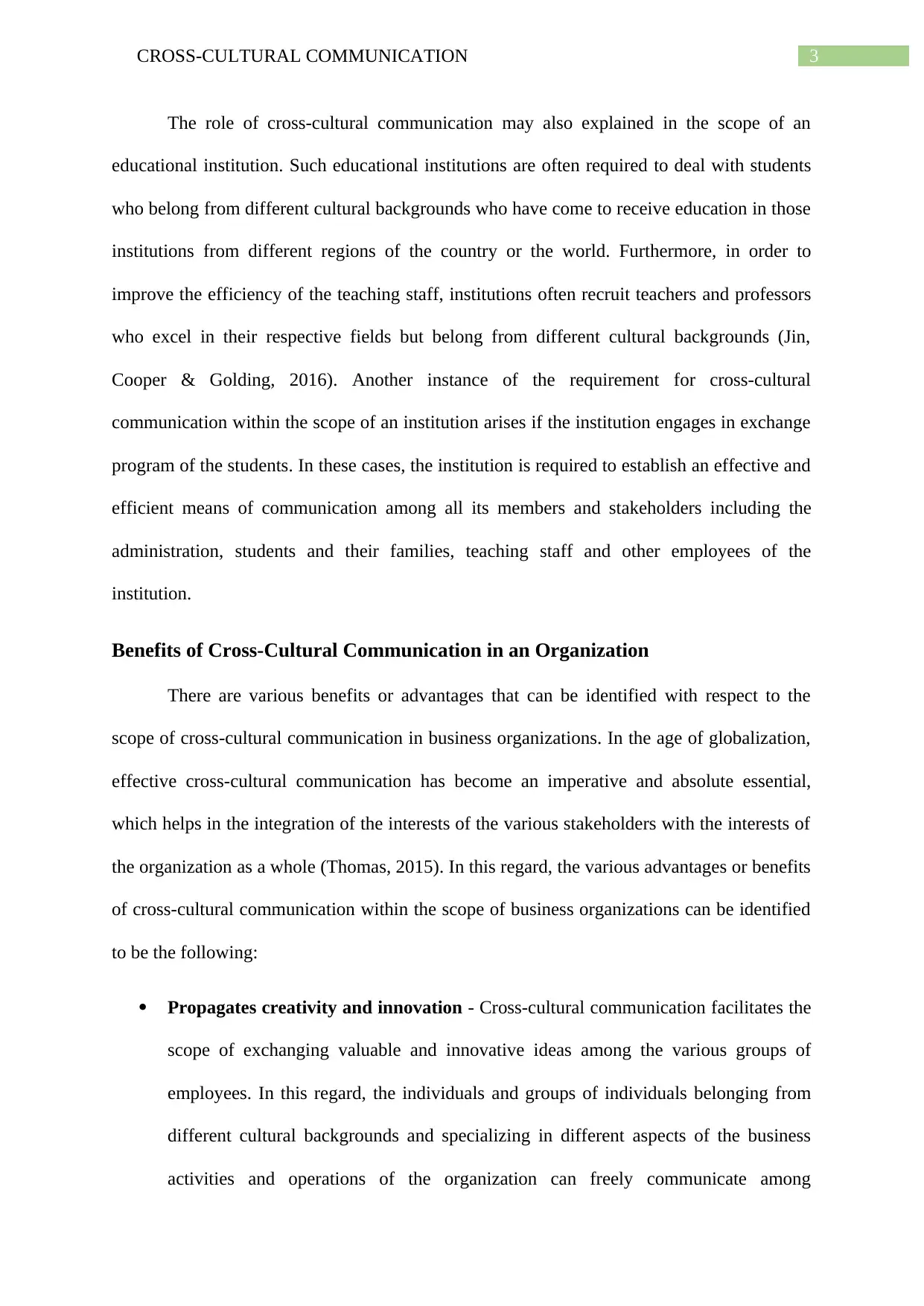
3CROSS-CULTURAL COMMUNICATION
The role of cross-cultural communication may also explained in the scope of an
educational institution. Such educational institutions are often required to deal with students
who belong from different cultural backgrounds who have come to receive education in those
institutions from different regions of the country or the world. Furthermore, in order to
improve the efficiency of the teaching staff, institutions often recruit teachers and professors
who excel in their respective fields but belong from different cultural backgrounds (Jin,
Cooper & Golding, 2016). Another instance of the requirement for cross-cultural
communication within the scope of an institution arises if the institution engages in exchange
program of the students. In these cases, the institution is required to establish an effective and
efficient means of communication among all its members and stakeholders including the
administration, students and their families, teaching staff and other employees of the
institution.
Benefits of Cross-Cultural Communication in an Organization
There are various benefits or advantages that can be identified with respect to the
scope of cross-cultural communication in business organizations. In the age of globalization,
effective cross-cultural communication has become an imperative and absolute essential,
which helps in the integration of the interests of the various stakeholders with the interests of
the organization as a whole (Thomas, 2015). In this regard, the various advantages or benefits
of cross-cultural communication within the scope of business organizations can be identified
to be the following:
Propagates creativity and innovation - Cross-cultural communication facilitates the
scope of exchanging valuable and innovative ideas among the various groups of
employees. In this regard, the individuals and groups of individuals belonging from
different cultural backgrounds and specializing in different aspects of the business
activities and operations of the organization can freely communicate among
The role of cross-cultural communication may also explained in the scope of an
educational institution. Such educational institutions are often required to deal with students
who belong from different cultural backgrounds who have come to receive education in those
institutions from different regions of the country or the world. Furthermore, in order to
improve the efficiency of the teaching staff, institutions often recruit teachers and professors
who excel in their respective fields but belong from different cultural backgrounds (Jin,
Cooper & Golding, 2016). Another instance of the requirement for cross-cultural
communication within the scope of an institution arises if the institution engages in exchange
program of the students. In these cases, the institution is required to establish an effective and
efficient means of communication among all its members and stakeholders including the
administration, students and their families, teaching staff and other employees of the
institution.
Benefits of Cross-Cultural Communication in an Organization
There are various benefits or advantages that can be identified with respect to the
scope of cross-cultural communication in business organizations. In the age of globalization,
effective cross-cultural communication has become an imperative and absolute essential,
which helps in the integration of the interests of the various stakeholders with the interests of
the organization as a whole (Thomas, 2015). In this regard, the various advantages or benefits
of cross-cultural communication within the scope of business organizations can be identified
to be the following:
Propagates creativity and innovation - Cross-cultural communication facilitates the
scope of exchanging valuable and innovative ideas among the various groups of
employees. In this regard, the individuals and groups of individuals belonging from
different cultural backgrounds and specializing in different aspects of the business
activities and operations of the organization can freely communicate among
Secure Best Marks with AI Grader
Need help grading? Try our AI Grader for instant feedback on your assignments.
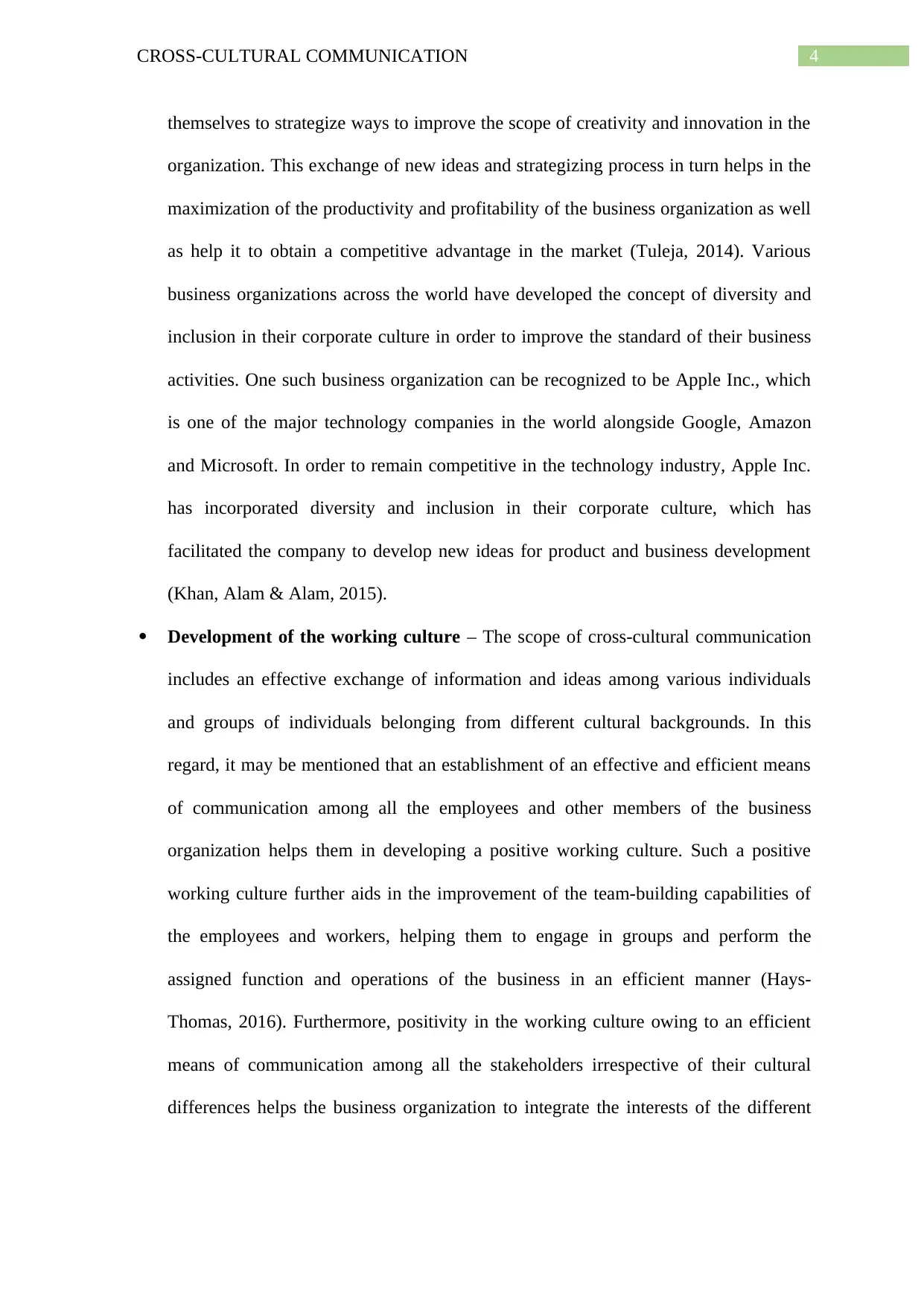
4CROSS-CULTURAL COMMUNICATION
themselves to strategize ways to improve the scope of creativity and innovation in the
organization. This exchange of new ideas and strategizing process in turn helps in the
maximization of the productivity and profitability of the business organization as well
as help it to obtain a competitive advantage in the market (Tuleja, 2014). Various
business organizations across the world have developed the concept of diversity and
inclusion in their corporate culture in order to improve the standard of their business
activities. One such business organization can be recognized to be Apple Inc., which
is one of the major technology companies in the world alongside Google, Amazon
and Microsoft. In order to remain competitive in the technology industry, Apple Inc.
has incorporated diversity and inclusion in their corporate culture, which has
facilitated the company to develop new ideas for product and business development
(Khan, Alam & Alam, 2015).
Development of the working culture – The scope of cross-cultural communication
includes an effective exchange of information and ideas among various individuals
and groups of individuals belonging from different cultural backgrounds. In this
regard, it may be mentioned that an establishment of an effective and efficient means
of communication among all the employees and other members of the business
organization helps them in developing a positive working culture. Such a positive
working culture further aids in the improvement of the team-building capabilities of
the employees and workers, helping them to engage in groups and perform the
assigned function and operations of the business in an efficient manner (Hays-
Thomas, 2016). Furthermore, positivity in the working culture owing to an efficient
means of communication among all the stakeholders irrespective of their cultural
differences helps the business organization to integrate the interests of the different
themselves to strategize ways to improve the scope of creativity and innovation in the
organization. This exchange of new ideas and strategizing process in turn helps in the
maximization of the productivity and profitability of the business organization as well
as help it to obtain a competitive advantage in the market (Tuleja, 2014). Various
business organizations across the world have developed the concept of diversity and
inclusion in their corporate culture in order to improve the standard of their business
activities. One such business organization can be recognized to be Apple Inc., which
is one of the major technology companies in the world alongside Google, Amazon
and Microsoft. In order to remain competitive in the technology industry, Apple Inc.
has incorporated diversity and inclusion in their corporate culture, which has
facilitated the company to develop new ideas for product and business development
(Khan, Alam & Alam, 2015).
Development of the working culture – The scope of cross-cultural communication
includes an effective exchange of information and ideas among various individuals
and groups of individuals belonging from different cultural backgrounds. In this
regard, it may be mentioned that an establishment of an effective and efficient means
of communication among all the employees and other members of the business
organization helps them in developing a positive working culture. Such a positive
working culture further aids in the improvement of the team-building capabilities of
the employees and workers, helping them to engage in groups and perform the
assigned function and operations of the business in an efficient manner (Hays-
Thomas, 2016). Furthermore, positivity in the working culture owing to an efficient
means of communication among all the stakeholders irrespective of their cultural
differences helps the business organization to integrate the interests of the different
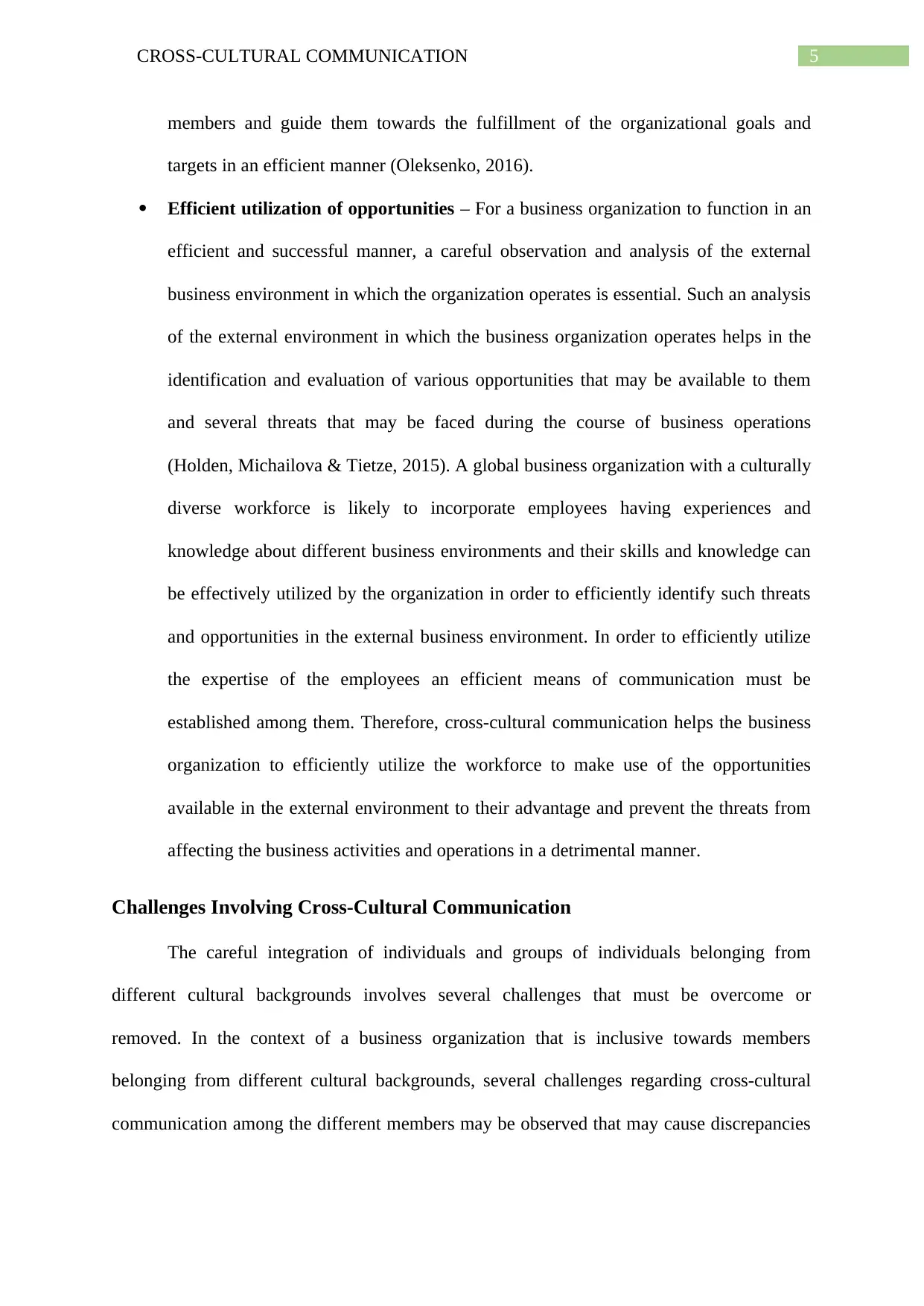
5CROSS-CULTURAL COMMUNICATION
members and guide them towards the fulfillment of the organizational goals and
targets in an efficient manner (Oleksenko, 2016).
Efficient utilization of opportunities – For a business organization to function in an
efficient and successful manner, a careful observation and analysis of the external
business environment in which the organization operates is essential. Such an analysis
of the external environment in which the business organization operates helps in the
identification and evaluation of various opportunities that may be available to them
and several threats that may be faced during the course of business operations
(Holden, Michailova & Tietze, 2015). A global business organization with a culturally
diverse workforce is likely to incorporate employees having experiences and
knowledge about different business environments and their skills and knowledge can
be effectively utilized by the organization in order to efficiently identify such threats
and opportunities in the external business environment. In order to efficiently utilize
the expertise of the employees an efficient means of communication must be
established among them. Therefore, cross-cultural communication helps the business
organization to efficiently utilize the workforce to make use of the opportunities
available in the external environment to their advantage and prevent the threats from
affecting the business activities and operations in a detrimental manner.
Challenges Involving Cross-Cultural Communication
The careful integration of individuals and groups of individuals belonging from
different cultural backgrounds involves several challenges that must be overcome or
removed. In the context of a business organization that is inclusive towards members
belonging from different cultural backgrounds, several challenges regarding cross-cultural
communication among the different members may be observed that may cause discrepancies
members and guide them towards the fulfillment of the organizational goals and
targets in an efficient manner (Oleksenko, 2016).
Efficient utilization of opportunities – For a business organization to function in an
efficient and successful manner, a careful observation and analysis of the external
business environment in which the organization operates is essential. Such an analysis
of the external environment in which the business organization operates helps in the
identification and evaluation of various opportunities that may be available to them
and several threats that may be faced during the course of business operations
(Holden, Michailova & Tietze, 2015). A global business organization with a culturally
diverse workforce is likely to incorporate employees having experiences and
knowledge about different business environments and their skills and knowledge can
be effectively utilized by the organization in order to efficiently identify such threats
and opportunities in the external business environment. In order to efficiently utilize
the expertise of the employees an efficient means of communication must be
established among them. Therefore, cross-cultural communication helps the business
organization to efficiently utilize the workforce to make use of the opportunities
available in the external environment to their advantage and prevent the threats from
affecting the business activities and operations in a detrimental manner.
Challenges Involving Cross-Cultural Communication
The careful integration of individuals and groups of individuals belonging from
different cultural backgrounds involves several challenges that must be overcome or
removed. In the context of a business organization that is inclusive towards members
belonging from different cultural backgrounds, several challenges regarding cross-cultural
communication among the different members may be observed that may cause discrepancies
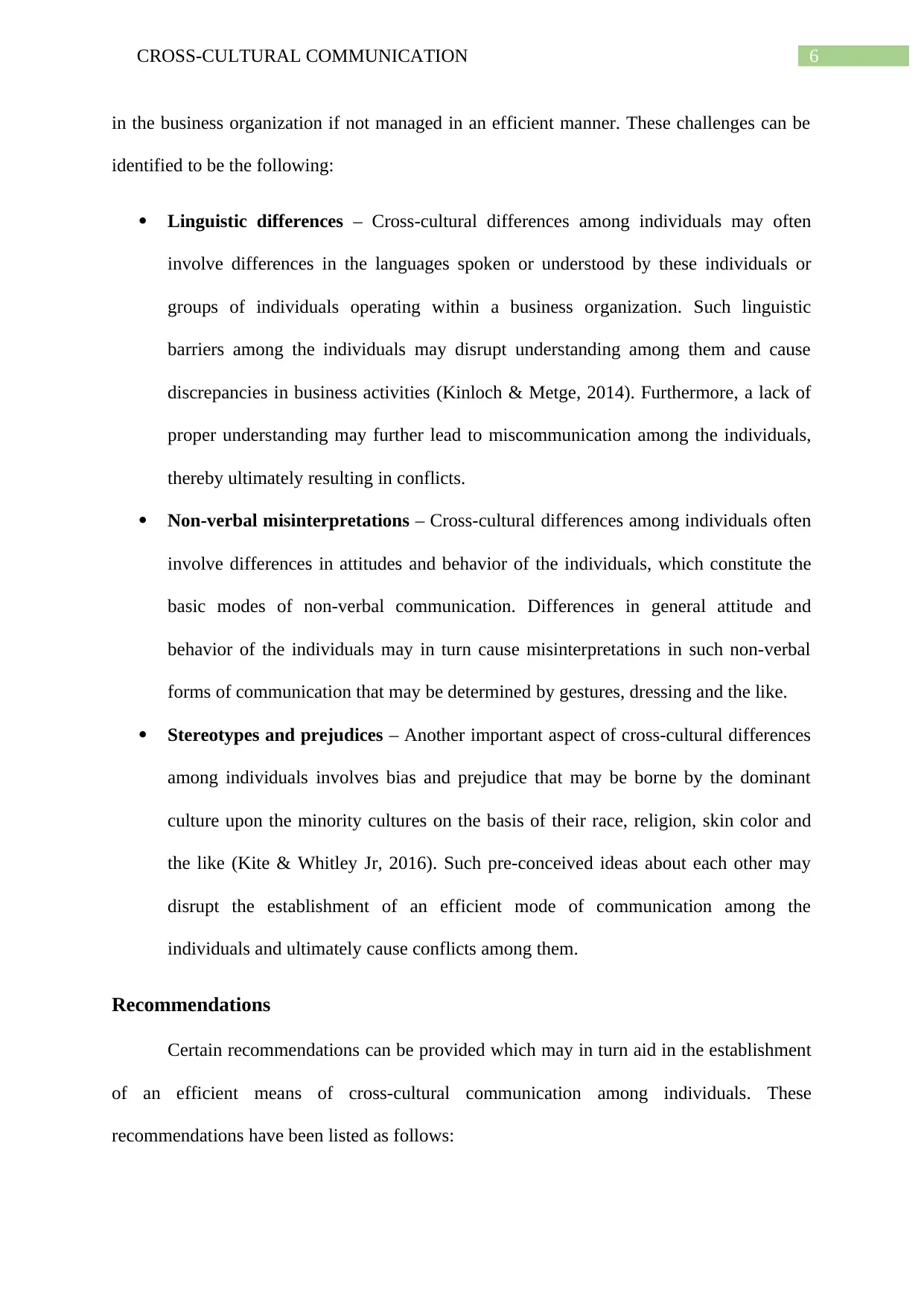
6CROSS-CULTURAL COMMUNICATION
in the business organization if not managed in an efficient manner. These challenges can be
identified to be the following:
Linguistic differences – Cross-cultural differences among individuals may often
involve differences in the languages spoken or understood by these individuals or
groups of individuals operating within a business organization. Such linguistic
barriers among the individuals may disrupt understanding among them and cause
discrepancies in business activities (Kinloch & Metge, 2014). Furthermore, a lack of
proper understanding may further lead to miscommunication among the individuals,
thereby ultimately resulting in conflicts.
Non-verbal misinterpretations – Cross-cultural differences among individuals often
involve differences in attitudes and behavior of the individuals, which constitute the
basic modes of non-verbal communication. Differences in general attitude and
behavior of the individuals may in turn cause misinterpretations in such non-verbal
forms of communication that may be determined by gestures, dressing and the like.
Stereotypes and prejudices – Another important aspect of cross-cultural differences
among individuals involves bias and prejudice that may be borne by the dominant
culture upon the minority cultures on the basis of their race, religion, skin color and
the like (Kite & Whitley Jr, 2016). Such pre-conceived ideas about each other may
disrupt the establishment of an efficient mode of communication among the
individuals and ultimately cause conflicts among them.
Recommendations
Certain recommendations can be provided which may in turn aid in the establishment
of an efficient means of cross-cultural communication among individuals. These
recommendations have been listed as follows:
in the business organization if not managed in an efficient manner. These challenges can be
identified to be the following:
Linguistic differences – Cross-cultural differences among individuals may often
involve differences in the languages spoken or understood by these individuals or
groups of individuals operating within a business organization. Such linguistic
barriers among the individuals may disrupt understanding among them and cause
discrepancies in business activities (Kinloch & Metge, 2014). Furthermore, a lack of
proper understanding may further lead to miscommunication among the individuals,
thereby ultimately resulting in conflicts.
Non-verbal misinterpretations – Cross-cultural differences among individuals often
involve differences in attitudes and behavior of the individuals, which constitute the
basic modes of non-verbal communication. Differences in general attitude and
behavior of the individuals may in turn cause misinterpretations in such non-verbal
forms of communication that may be determined by gestures, dressing and the like.
Stereotypes and prejudices – Another important aspect of cross-cultural differences
among individuals involves bias and prejudice that may be borne by the dominant
culture upon the minority cultures on the basis of their race, religion, skin color and
the like (Kite & Whitley Jr, 2016). Such pre-conceived ideas about each other may
disrupt the establishment of an efficient mode of communication among the
individuals and ultimately cause conflicts among them.
Recommendations
Certain recommendations can be provided which may in turn aid in the establishment
of an efficient means of cross-cultural communication among individuals. These
recommendations have been listed as follows:
Paraphrase This Document
Need a fresh take? Get an instant paraphrase of this document with our AI Paraphraser
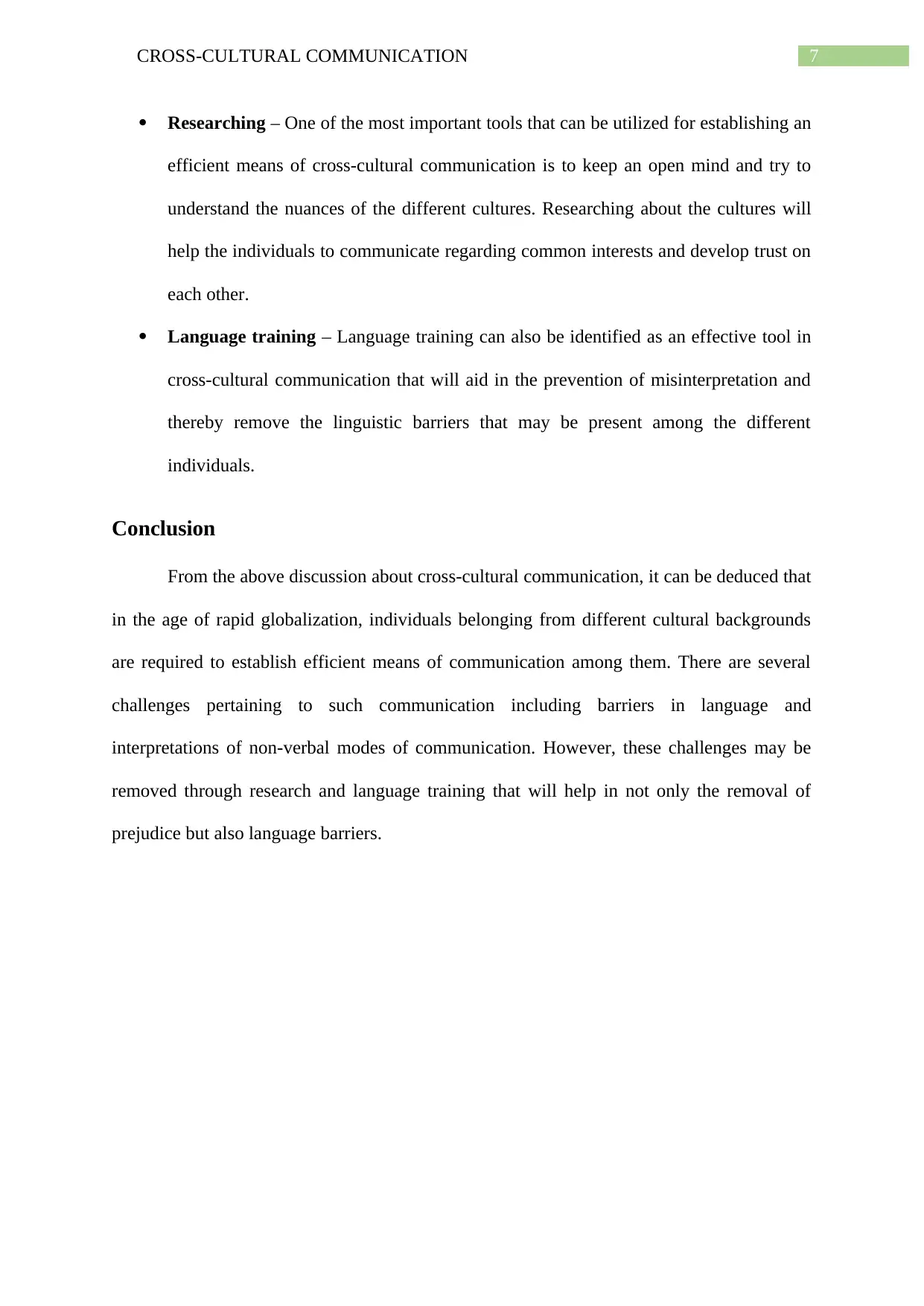
7CROSS-CULTURAL COMMUNICATION
Researching – One of the most important tools that can be utilized for establishing an
efficient means of cross-cultural communication is to keep an open mind and try to
understand the nuances of the different cultures. Researching about the cultures will
help the individuals to communicate regarding common interests and develop trust on
each other.
Language training – Language training can also be identified as an effective tool in
cross-cultural communication that will aid in the prevention of misinterpretation and
thereby remove the linguistic barriers that may be present among the different
individuals.
Conclusion
From the above discussion about cross-cultural communication, it can be deduced that
in the age of rapid globalization, individuals belonging from different cultural backgrounds
are required to establish efficient means of communication among them. There are several
challenges pertaining to such communication including barriers in language and
interpretations of non-verbal modes of communication. However, these challenges may be
removed through research and language training that will help in not only the removal of
prejudice but also language barriers.
Researching – One of the most important tools that can be utilized for establishing an
efficient means of cross-cultural communication is to keep an open mind and try to
understand the nuances of the different cultures. Researching about the cultures will
help the individuals to communicate regarding common interests and develop trust on
each other.
Language training – Language training can also be identified as an effective tool in
cross-cultural communication that will aid in the prevention of misinterpretation and
thereby remove the linguistic barriers that may be present among the different
individuals.
Conclusion
From the above discussion about cross-cultural communication, it can be deduced that
in the age of rapid globalization, individuals belonging from different cultural backgrounds
are required to establish efficient means of communication among them. There are several
challenges pertaining to such communication including barriers in language and
interpretations of non-verbal modes of communication. However, these challenges may be
removed through research and language training that will help in not only the removal of
prejudice but also language barriers.
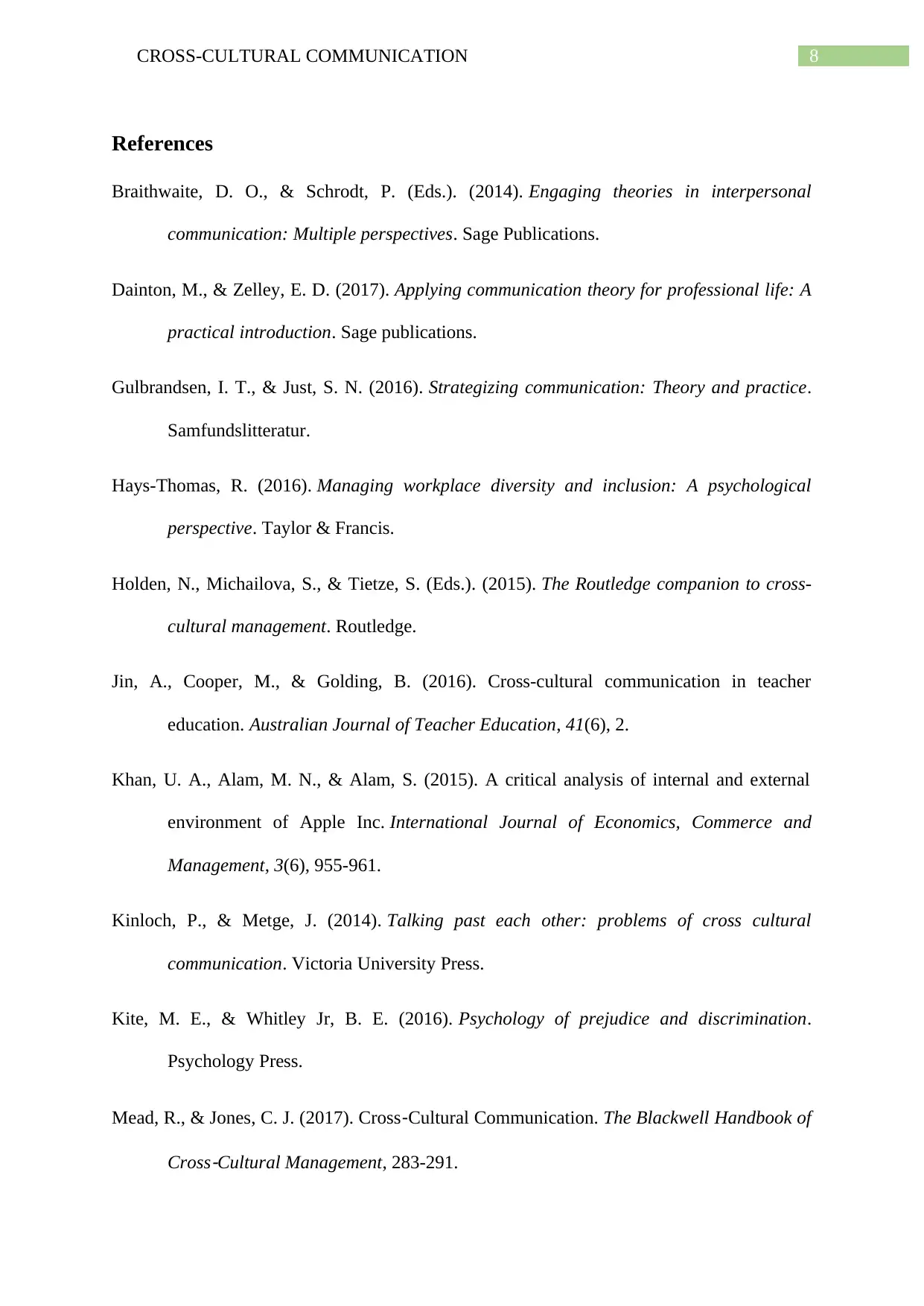
8CROSS-CULTURAL COMMUNICATION
References
Braithwaite, D. O., & Schrodt, P. (Eds.). (2014). Engaging theories in interpersonal
communication: Multiple perspectives. Sage Publications.
Dainton, M., & Zelley, E. D. (2017). Applying communication theory for professional life: A
practical introduction. Sage publications.
Gulbrandsen, I. T., & Just, S. N. (2016). Strategizing communication: Theory and practice.
Samfundslitteratur.
Hays-Thomas, R. (2016). Managing workplace diversity and inclusion: A psychological
perspective. Taylor & Francis.
Holden, N., Michailova, S., & Tietze, S. (Eds.). (2015). The Routledge companion to cross-
cultural management. Routledge.
Jin, A., Cooper, M., & Golding, B. (2016). Cross-cultural communication in teacher
education. Australian Journal of Teacher Education, 41(6), 2.
Khan, U. A., Alam, M. N., & Alam, S. (2015). A critical analysis of internal and external
environment of Apple Inc. International Journal of Economics, Commerce and
Management, 3(6), 955-961.
Kinloch, P., & Metge, J. (2014). Talking past each other: problems of cross cultural
communication. Victoria University Press.
Kite, M. E., & Whitley Jr, B. E. (2016). Psychology of prejudice and discrimination.
Psychology Press.
Mead, R., & Jones, C. J. (2017). Cross‐Cultural Communication. The Blackwell Handbook of
Cross
‐Cultural Management, 283-291.
References
Braithwaite, D. O., & Schrodt, P. (Eds.). (2014). Engaging theories in interpersonal
communication: Multiple perspectives. Sage Publications.
Dainton, M., & Zelley, E. D. (2017). Applying communication theory for professional life: A
practical introduction. Sage publications.
Gulbrandsen, I. T., & Just, S. N. (2016). Strategizing communication: Theory and practice.
Samfundslitteratur.
Hays-Thomas, R. (2016). Managing workplace diversity and inclusion: A psychological
perspective. Taylor & Francis.
Holden, N., Michailova, S., & Tietze, S. (Eds.). (2015). The Routledge companion to cross-
cultural management. Routledge.
Jin, A., Cooper, M., & Golding, B. (2016). Cross-cultural communication in teacher
education. Australian Journal of Teacher Education, 41(6), 2.
Khan, U. A., Alam, M. N., & Alam, S. (2015). A critical analysis of internal and external
environment of Apple Inc. International Journal of Economics, Commerce and
Management, 3(6), 955-961.
Kinloch, P., & Metge, J. (2014). Talking past each other: problems of cross cultural
communication. Victoria University Press.
Kite, M. E., & Whitley Jr, B. E. (2016). Psychology of prejudice and discrimination.
Psychology Press.
Mead, R., & Jones, C. J. (2017). Cross‐Cultural Communication. The Blackwell Handbook of
Cross
‐Cultural Management, 283-291.
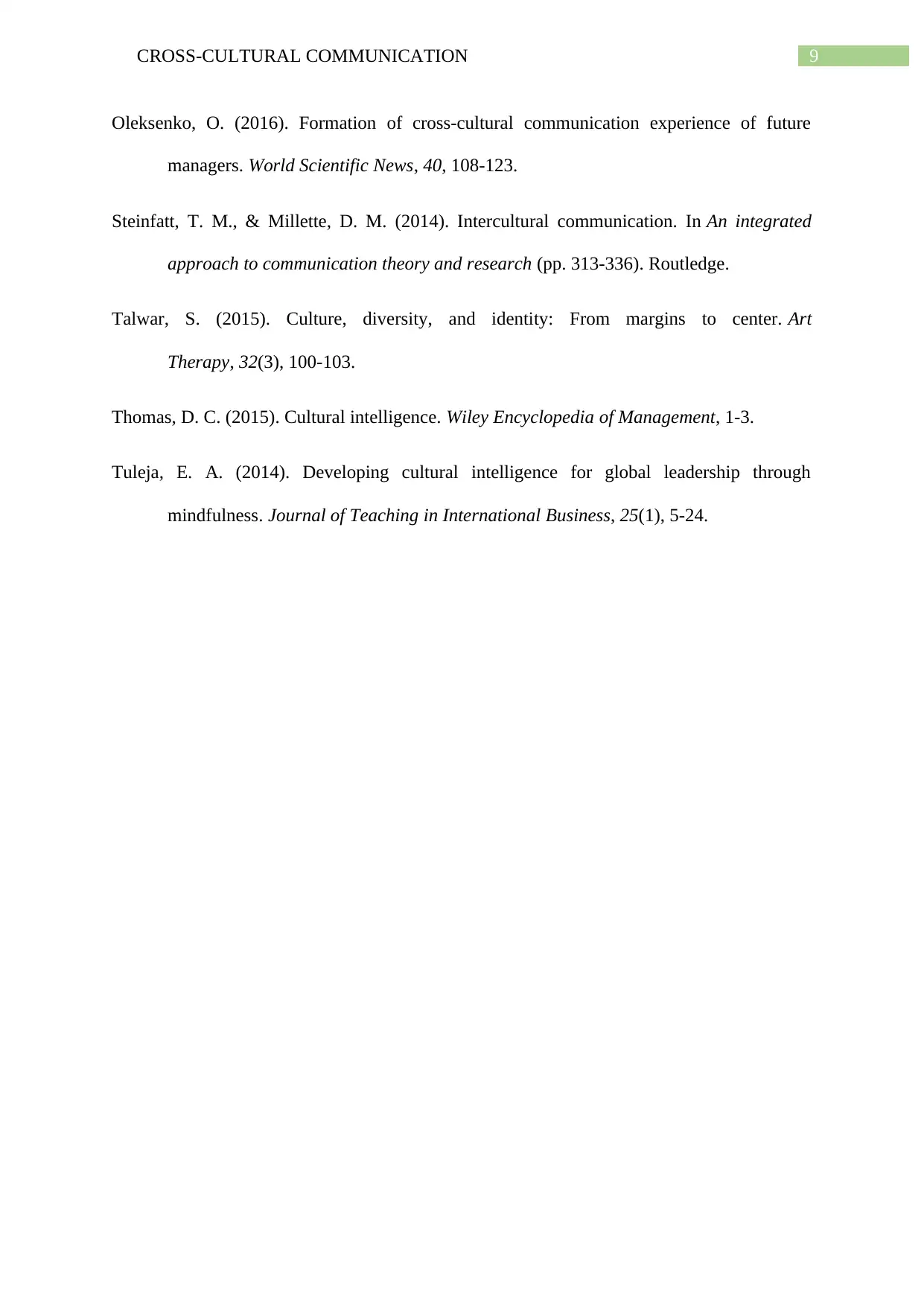
9CROSS-CULTURAL COMMUNICATION
Oleksenko, O. (2016). Formation of cross-cultural communication experience of future
managers. World Scientific News, 40, 108-123.
Steinfatt, T. M., & Millette, D. M. (2014). Intercultural communication. In An integrated
approach to communication theory and research (pp. 313-336). Routledge.
Talwar, S. (2015). Culture, diversity, and identity: From margins to center. Art
Therapy, 32(3), 100-103.
Thomas, D. C. (2015). Cultural intelligence. Wiley Encyclopedia of Management, 1-3.
Tuleja, E. A. (2014). Developing cultural intelligence for global leadership through
mindfulness. Journal of Teaching in International Business, 25(1), 5-24.
Oleksenko, O. (2016). Formation of cross-cultural communication experience of future
managers. World Scientific News, 40, 108-123.
Steinfatt, T. M., & Millette, D. M. (2014). Intercultural communication. In An integrated
approach to communication theory and research (pp. 313-336). Routledge.
Talwar, S. (2015). Culture, diversity, and identity: From margins to center. Art
Therapy, 32(3), 100-103.
Thomas, D. C. (2015). Cultural intelligence. Wiley Encyclopedia of Management, 1-3.
Tuleja, E. A. (2014). Developing cultural intelligence for global leadership through
mindfulness. Journal of Teaching in International Business, 25(1), 5-24.
1 out of 10
Related Documents
Your All-in-One AI-Powered Toolkit for Academic Success.
+13062052269
info@desklib.com
Available 24*7 on WhatsApp / Email
![[object Object]](/_next/static/media/star-bottom.7253800d.svg)
Unlock your academic potential
© 2024 | Zucol Services PVT LTD | All rights reserved.



